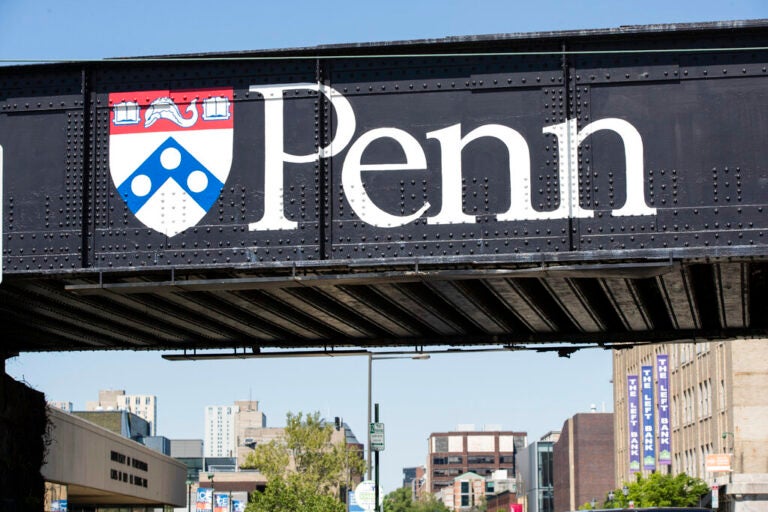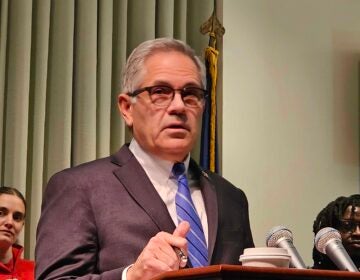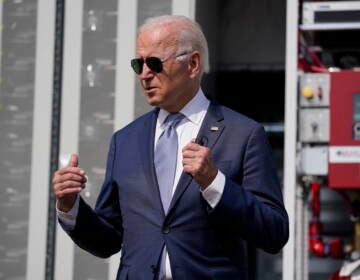Penn and Rutgers warn new federal rules meant to lower drug prices have ‘unintended consequences’
Local research universities are pushing for new Biden administration rules about licensing taxpayer-funded technology to be repealed.

University of Pennsylvania in Philadelphia Wednesday, May 15, 2019. (AP Photo/Matt Rourke)
From Philly and the Pa. suburbs to South Jersey and Delaware, what would you like WHYY News to cover? Let us know!
There’s a fear that the lynchpin of a technology ecosystem that allows institutions to make money from discoveries while inventors are working on federally funded research projects may be coming loose.
The Biden administration is targeting a system research institutions have relied upon for four decades to force companies developing pharmaceutical drugs to lower the cost of medications.
For years, universities were unable to commercialize technology developed with taxpayer money. Then the Bayh-Dole Act of 1980 changed that dynamic — universities created technology transfer offices and began licensing patents to startups and big corporations alike.
At the crux of the issue is a public safeguard feature known as march-in rights, meaning the government can take back control of patents if the licensee doesn’t make the product reasonably available to the public. That march-in rights measure has never been used before.
But now there’s a new draft framework for Bayh-Dole that asserts reasonable access to the public means it’s not overpriced in the market.
The University of Pennsylvania is just one research institution that is pushing for the new rules to be repealed.
“It’ll discourage the private sector from wanting to invest,” said John Swartley, Ph.D., chief innovation officer at the University of Pennsylvania. “The overarching goal of making sure patients are able to afford and access health care they need is 100% in our mission, and we’re supportive of that. But using march-in rights for this particular purpose to reduce the cost of therapeutic drugs isn’t going to work. And it will affect not just drugs, but any discovery that’s made using federal funds.”
Swartley is just one of dozens of university technology transfer managers who argue that the rule changes won’t accomplish the goal because pharmaceutical drugs are created using more than one patent — most are developed by corporations during the research and development process.
It’s more likely that the foundation of a new pharmaceutical drug came from university research.
“Many of these discoveries are at a very early stage. They require a lot of work before they would be turned into a commercial product — they’re like a good idea,” said Mike Zwick, senior vice president for research at Rutgers University.
Rutgers University generates about $12 million in licensing revenue across 800 licensing agreements with its researchers. More than $500 million in federal grants supported research at Rutgers University in fiscal year 2023. Rutgers University researchers helped develop the first COVID-19 saliva test during the pandemic.
The University of Pennsylvania generated more licensing revenue than any other university nationwide — more than $1 billion — during fiscal 2023. Nearly $800 million in federal grants supported research at the university in fiscal year 2021, the most recent data available.
In the past decade, technology startups cofounded by University of Pennsylvania faculty have been awarded 74 grants through the federal Small Business Innovation Research and Small Business Technology Transfer programs, which translated to $43 million in early stage capital.
Swartley worries about companies taking a big step back from university technology because they don’t want to risk losing access to patents tied to federally funded research.
“They’re not going to want to risk all of that capital if there’s a legitimate concern they could make a substantial investment and then have the license pulled out from under them,” he said.
Some potential licensees are already demanding that “unacceptable iron-clad guarantees from institutions like Penn and their licenses and the output of company-funded R&D programs will not be disturbed by federal march-in rights,” according to a letter the University of Pennsylvania submitted to the National Institute of Standards and Technology.
Federal research often supports scientific breakthroughs years before the technology can be commercialized. Research to develop mRNA technology by Katalin Karikó, Ph.D. and Dr. Drew Weisman, Ph.D. at the University of Pennsylvania contributed to COVID-19 vaccine research. The pair was supported by $2.3 million in federal grants from the National Institute of Allergy and Infectious Diseases.
Pharmaceutical giants Moderna and Pfizer licensed that mRNA technology from the University of Pennsylvania for its COVID-19 vaccine development.
The average American did not pay anything out of pocket for COVID-19 vaccines. Instead, the vaccines, which cost between $30 and $39 per dose, were purchased in bulk by the federal government.
Consumer advocates say affordable medicine in the market would be the best-case scenario for more taxpayer-funded research and support the Biden administration’s new rules.
“We think it’s just plainly unreasonable if U.S. consumers are paying multiple times more for the same drug than other high-income countries when we paid to invent it,” said Steve Knievel, advocate for Public Citizen’s Access to Medicines program, a national nonprofit. “There’s plenty of room for drug corporations to make healthy and substantial profits even if the government is judiciously exercising its rights to protect the public interest.”
Knievel said the pharmaceutical industry has fought tooth and nail against any measures to rein in costs for decades.
“I’ve seen reforms big and small. The pharma talking points are often very much the same about how it’s going to kill innovation,” he said. “We are confident that grant dollars would continue to flow to universities and they would continue to be interested parties to license and work with universities on taxpayer-funded [research] even if these march-in rights are exercised in certain narrow cases of abuses of the public interest.”
For example, the federal government considered using its march-in rights last year to try and bring down the cost of a pricey pharmaceutical drug.
The University of California, Los Angeles had licensed androgen receptor blocker technology from its researchers to drug manufacturer Medivation, which developed the prostate cancer drug Xtandi. Medivation was ultimately acquired by Pfizer. UCLA generated more than $520 million from royalties for Xtandi technology.
The wholesale cost of Xtandi is between $160,000 and $180,000 per patient each year.
The National Institutes of Health ultimately rejected the petition to use that safeguard measure in March 2023.
But it’s unclear what might happen next time.
For now, the National Institute of Standards and Technology is reviewing more than 51,000 public comments.
Some are concerned that the coordinated effort to develop medicine during the COVID-19 pandemic might not be possible under the new rules.
“The reason you had the response we had to COVID-19 was because Bayh-Dole assured people the rules are predictable, governments are a reliable partner. And you had industry and government and federal laboratories come together,” said Joseph Allen, executive director of the Bayh-Dole Coalition and former president of the National Technology Transfer Center. “Now the concern is that the government is not a reliable partner because suddenly they’ve just changed all the rules. That’s really what we’re facing right now. No one knows what’s going to happen next.”

Get daily updates from WHYY News!
WHYY is your source for fact-based, in-depth journalism and information. As a nonprofit organization, we rely on financial support from readers like you. Please give today.







